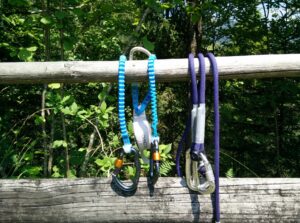
Why you should use a via ferrata set with tear-out webbing? On the left via ferrata set with tear-out webbing and on the right an old via ferrata set with friction metal plate
If you are into via ferrata trails, you probably know that via ferrata sets utilize either tear-out webbing or a friction metal plate as an energy absorber/braking mechanism. The energy absorber is what makes a potential fall more tolerable as it stops the fall gradually rather than abruptly, and thus prevents fatal injuries. Even a short fall directly on a static rope can be very severe in terms of the impact force and therefore an energy absorber is a must when it comes to via ferrata sets.
Until 2010 most via ferrata sets utilized a friction metal plate for energy absorption. However, nowadays tear-out webbing is the norm. As a matter of fact, most reputable brands have completely stopped producing via ferrata sets with friction metal plates. Nevertheless, such sets are still available at some retailers as well as and on the second-hand market. I used a via ferrata set with a friction metal plate for almost 12 years (2007 to 2019) and recently switched to Petzl Scorpio which utilizes tear-out webbing. In the following I will explain the advantages and disadvantages of tear-out webbing. But let’s start with the basics and explain how both mechanisms work. If you are new to via ferrata gear, check out my article How to use via ferrata equipment as well. It will help you to understand the topic better.
Table of Contents:
- Tear-Out Webbing vs Friction Metal Plate: How does it work?
- Advantages of tear-out webbing
- Disadvantages of tear-out webbing
- Conclusion
Tear-Out Webbing vs Friction Metal Plate: How does it work?
Sets with tear-out webbing have a pouch close to the attachment loop. Inside this pouch you will find a long webbing which has been folded and stitched together for every individual fold. If you fall, the stitches will start tearing one by one and the webbing will unfold bit by bit. Therefore, you will gradually stop, and the impact force will be distributed. The pouch can be opened so that you can inspect the webbing. If the stitches are torn, the via ferrata set should be discarded.
At lanyards with a friction metal plate the rope from both arms goes through this friction plate. Usually the rope after the friction plate is at least one meter long. In case of a fall, the rope will slide through the friction plate and thus reduce the impact force.
Advantages of tear-out webbing
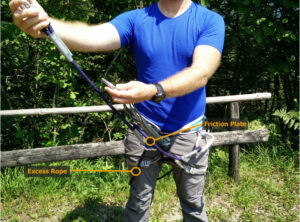
On the image an old via ferrata set with the friction metal plate. Excess rope at the friction brake often comes in the way while you are climbing. That is not the case with via ferrata sets that utilize tear-out webbing.
When I switched from my old via ferrata set with a friction brake to Petzl Scorpio with tear-out webbing I immediately noticed several advantages. The biggest advantage is that there is no excess rope which could get in the way when you are climbing. Via ferrata sets with friction brake have an excess rope at the friction plate (see image) and it’s up to you to deal with it. I typically attached it to my climbing harness with Velcro, but it often got hooked around sharp rocks and detached. Of course, this usually happened during the very hardest stretches where I then had to fumble around to reattach the excess rope to the climbing harness.
Another thing to consider is safety. Manufacturers of friction plates often warn that the excess rope will slide slower through the friction plate in wet conditions. This means that if the rope gets wet, a potential fall will be more abrupt as the excess rope won’t be able to slide through the friction plate as fast as it would in dry conditions. Now, this is not a major problem as via ferratas are not something you do in rain but it is, nevertheless, a disadvantage. The weather in mountainous areas is unpredictable and it is indeed possible to get caught in a sudden rain shower.
Sets with tear-out webbing are typically also lighter than sets with friction plate (fabric is lighter than metal) and it is of course good to have lightweight gear for climbing. My new Petzl Scorpio via ferrata set with tear-out webbing is more than 100 grams lighter than my previous via ferrata set with friction brake. Learn more about why it’s important to use lightweight gear for outdoor activities in my article Why hike lightweight.
Disadvantages of tear-out webbing
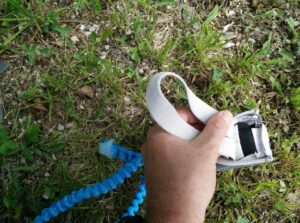
If the webbing tears, the whole via ferrata set has to be replaced. A substantial amount of force is required to tear the webbing.
The only disadvantage of tear-out webbing that comes to my mind – which is also often mentioned by various sources – is that the via ferrata set in question has to be discarded after a fall (if the webbing tears). You obviously can’t (and shouldn’t try to!) fix the torn webbing. However, after a serious fall it’s a good idea to replace the via ferrata set, no matter which shock absorption mechanism it uses. It’s not only the shock absorption mechanism itself that suffers from the fall but also the carabiners and ropes of the via ferrata set. Especially carabiners are problematic because they can microfracture when they bump against the iron rod and rocks, and weaken to such an extent that they are no longer safe to use. Microfractures are tricky because they are invisible to the naked eye. Learn more about microfractures in this interesting article from UIAA.
Note that the webbing will tear only if proper force is applied to it. For example, Petzl’s tear-out webbings require a tearing force of between 1.2 and 6 kN (120 – 600 kg). Therefore, you can still rest on the via ferrata set without damaging the webbing and, depending on your weight, it will also withstand soft falls without tearing.
Conclusion
If you are still using a via ferrata set with friction brake, I highly recommend replacing it for a set with tear-out webbing. Via ferrata sets with tear-out webbing are safer, lighter and less clumsy (there is no excess rope dangling around). The fact that they should be discarded after a fall is also not such a big disadvantage as you should anyway discard any via ferrata set after a serious fall. If you are buying a new via ferrata set from private sellers, do check that you are not buying an old product with friction brake. On the other hand, trusted retailers have removed such via ferrata sets from their offer long ago.
I’d love to hear about your thoughts on via ferrata sets. Write them in the comments section below.
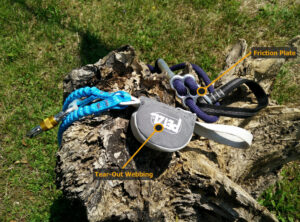

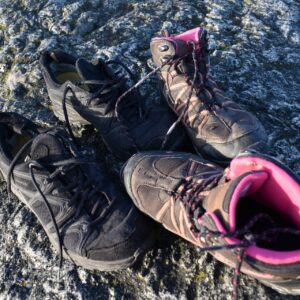
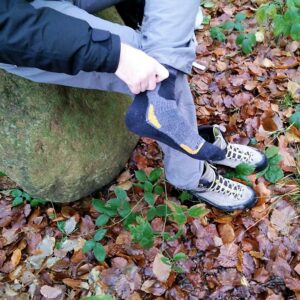

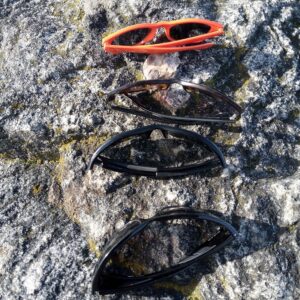















My climbing partner and I recently looked at hiring VF kit for our rest day during a climbing trip to Morocco. When we inspected the kit we were shocked to see that it had already ripped (or perhaps been unpicked), and there was a tag saying “last inspection date 2011”. Needless to say we didn’t hire the kit, but inexperienced people would not know to check this and the local hirer whose kit it was was clueless. Its an accident waiting to happen.
Hi Alison,
I’m happy you figured out that the set wasn’t functional before you went climbing with it. Only rent climbing gear from reputable companies because climbing gear has to be handled with care and regularly inspected. There are also items where you can’t see if they are no longer safe to use. For example, if a carabiner fells from high altitude it can develop micro fractures which make it dangerous to use. However, these micro fractures can’t be seen with a naked eye. I only use my own climbing harness and VF set, but I understand that if you’re travelling that’s not always an option.
Regards,
Blaz
hello, if someone takes a fall and the tear out webbing actually tears out, assuming they are uninjured, how do they exit the situation? Can they continue to the end of the via ferrata with this or are they rendered stranded and in need of rescue because of broken equipment?
Thank you for the information, Steve-
Hi Steven,
I think most people continue to the end with a torn-out webbing. However, if a person is unable to continue due to shock or injuries, rescue services have to be called.
Best regards,
Blaz